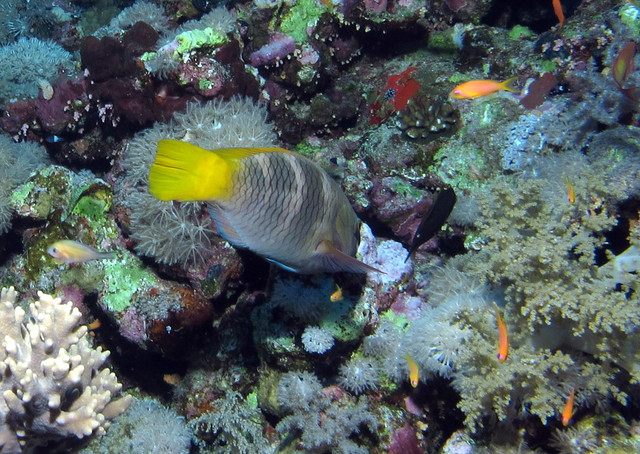An estuarine habitat is very important for a lot of species
due to freshwater and marine conditions, ecological reasons recreational
reasons, and commercial importance. Salinity levels fluctuate, the tides go
through cycles, and there is input from upstream freshwater flows. All of these
factors determine the density population of the American Alligator within the
estuary. Other factors that contribute are reproductive cycles and temperature.
Figure 1: An American Alligator eating a shark.
Alligator
mississippiensis¸ or the American Alligator, is a primarily freshwater
species. It is spatially and temporally heterogeneous largely due to a salinity
gradient that fluctuates. This species hangs around the estuary near the
Atlantic Ocean in Southern Florida. The density of alligators in the downstream
zone was lower than that of the midstream zone during the dry season when
salinity increases due to reduced precipitation. Conversely, the density of the
large size alligators was higher in the downstream zone than in the midstream
zone because of the wet season, probably due to a decrease in salinity
concentration. The authors’ results indicated high adaptability of alligators
to the fluctuating habitat conditions. Use of estuaries by alligators is likely
driven in part by physiology and by reproductive cycles, and their results
supported the alligators’ opportunistic use of estuary habitat and ontogenetic
niche shifts.
The American Alligator is an intriguing candidate for this
study. The researchers were curious to the drive of alligators to and from the
estuary. They found that typically the only alligators present in the estuary
were of the larger class size because of their smaller surface area to volume
ratio whereas the small class has a higher surface area to volume ratio.
Alligators have a limited osmoregulatory capability in saline environments.
Alligator nests were not found in moderate-high salinity areas, which suggests
that salinity has a strong effect on the nesting sites of alligators. Therefore,
altered salinity by changes in freshwater flows into estuaries likely affects
the location of alligators, hence why they travel upstream during droughts and
travel downstream during the wet season. The researchers used a long-term
monitoring program to determine trends in relative density of alligators in the
Shark River estuary.

Figure 2: An American Alligator eating what presumably looks like a large fish or a small shark.
Large alligators may make more frequent excursions to the
downstream zone during the wet season because of lower salinity and higher
temperature. As a mobile top predator, the alligator transfers energy and
nutrients by their movement and foraging activities across ecosystems. In this
study, the alligator connects freshwater, estuary, and near-marine zones by
their movement and foraging. During the dry season, it is noted that the adult
male alligators spend twice as much of their time in an upstream zone. The
larger alligators are more tolerant to salinity concentration differences.
Because of their tolerance, they have more foraging options, especially in the
Shark River.
Recent surveys indicate the declining density of alligators
in multiple wetland compartments in southern Florida, even up to a 99% decline
in the southern Everglades. Historically, population counts were higher, but
recently, due to human and nature involvement (droughts), the density has
decreased. Human development has disturbed these estuaries and the many life
forms that call these places home. There are efforts to improve the conditions
in the southern estuaries to more natural patterns. If restoration is achieved,
it is expected that alligator density will increase and that more medium and small
class size alligators will be observed as salinity becomes more favorable, whereas
in this study mostly large sized alligators will observed.
Typically all class size alligators consume estuary/marine
species including mud crabs, horseshoe crabs, blue crabs, grass shrimp, and
fish, but juvenile alligators consumed less frequently than larger alligators. Large-sized alligators do travel downstream into the estuaries where other predators are present. Alligators will eat anything that typically fits into their mouths which begs
the question, what if there is a competing predator. With this in mind, do
alligators come across sharks and what happens?
It is reported that alligators and sharks do come into
contact, and the outcome is interesting regarding encounters of sharks with
alligators and then again with crocodiles. “Alligators are opportunistic” and
surely they wouldn’t pass up a “big chunk of protein that’s swimming by.” There
is evidence of alligators eating lemon, nurse, and bonnethead sharks, as well
as an Atlantic stingray. “Gators will eat almost anything that will fit in their
mouths” says a researcher at the Northwestern State University of Louisiana,
though the researcher points out that he has never found shark remains in the
stomach of an alligator. This may be due to the highly acidic stomachs of the
alligators, which could dissolve the cartilaginous skeletons of sharks with
little trace. The literature was searched for crocodile encounters, and the
conclusion was quite the opposite. The crocodile, more often than not, was the
prey in many cases—great white sharks preying on American crocodiles in
Columbia and tiger sharks eating estuarine crocodiles in Australia.
References
Fujisaki, I., Hart, K., Cherkiss, M., Mazzotti, F.,
Beauchamp, J., Jeffrey, B., & Brandt, L. (2016). Spatial and Temporal
Variability in Estuary Habitat Use by American Alligators. Estuaries & Coasts, 39(5), 1561-1569. Doi:10.1007/s12237-016-0084-2

















